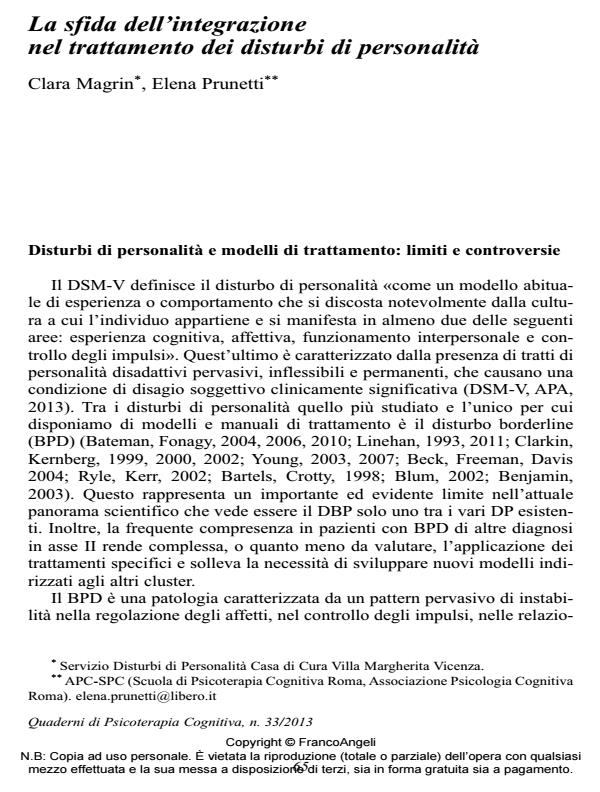La sfida dell’integrazione nel trattamento dei disturbi di personalità
Titolo Rivista QUADERNI DI PSICOTERAPIA COGNITIVA
Autori/Curatori Clara Magrin, Elena Prunetti
Anno di pubblicazione 2013 Fascicolo 2013/33
Lingua Italiano Numero pagine 16 P. 65-80 Dimensione file 141 KB
DOI 10.3280/QPC2013-033005
Il DOI è il codice a barre della proprietà intellettuale: per saperne di più
clicca qui
Qui sotto puoi vedere in anteprima la prima pagina di questo articolo.
Se questo articolo ti interessa, lo puoi acquistare (e scaricare in formato pdf) seguendo le facili indicazioni per acquistare il download credit. Acquista Download Credits per scaricare questo Articolo in formato PDF

FrancoAngeli è membro della Publishers International Linking Association, Inc (PILA)associazione indipendente e non profit per facilitare (attraverso i servizi tecnologici implementati da CrossRef.org) l’accesso degli studiosi ai contenuti digitali nelle pubblicazioni professionali e scientifiche
In questo articolo si mette in evidenza come il panorama scientifico stia sempre più sottolineando la necessità di proporre modelli integrati di intervento per il trattamento dei disturbi di personalità. L’attenzione è rivolta, soprattutto, al disturbo borderline, l’unico che ha vari studi empirici che dimostrano l’efficacia di trattamenti specialistici. Oggi abbiamo, infatti, a disposizione vari modelli di cura derivanti da scuole di pensiero diverse, tutti con prove di efficacia, ma nessuno di questi ha dati sufficientemente robusti tali da dichiararne una superiorità rispetto agli altri. Nel presente lavoro saranno ripresi i vari trattamenti e le specificità di ciascuno evidenziando l’assenza di un modello onnicomprensivo adatto a tutti i pazienti aventi un disturbo di personalità. La disamina verterà sull’utilità di sviluppare cure efficaci che possano essere flessibili attingendo tecniche da differenti approcci in modo da consentire ai terapeuti di adattare gli interventi sul singolo paziente. In conclusione verrà presentata un’esperienza di integrazione svolta presso un Servizio per il trattamento ospedaliero dei disturbi di personalità con primi risultati di outcome.
Parole chiave:Trattamenti integrati, borderline, disturbi di personalità.
Clara Magrin, Elena Prunetti, La sfida dell’integrazione nel trattamento dei disturbi di personalità in "QUADERNI DI PSICOTERAPIA COGNITIVA" 33/2013, pp 65-80, DOI: 10.3280/QPC2013-033005